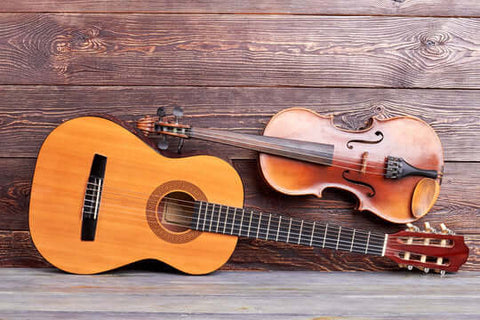An Overview of Stringed instruments: From Bows to Strings
Stringed instruments have always held a prominent position in the world of music, enchanting listeners with their melodious tunes. Whether it's the graceful melodies produced by a violin or the rhythmic strumming of a guitar, these instruments have captivated audiences for centuries. This blog post aims to delve deeper into the various types of stringed instruments and explore what makes them truly special.
The Importance of Bows: A Vital Element
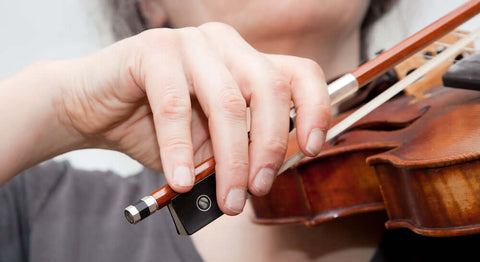
A crucial component found in stringed musical intrument is the bow. Traditionally crafted using horsehair and different types of wood, a bow consists of a curved stick with tensioned hair that creates sound when drawn across the strings. The tension in the bow hair plays a significant role in determining both volume and sound quality. Musicians often possess an assortment of bows made from different materials and designs, allowing them to create diverse tones and employ various techniques while playing.
1. The Violin Family: Masters of Melody
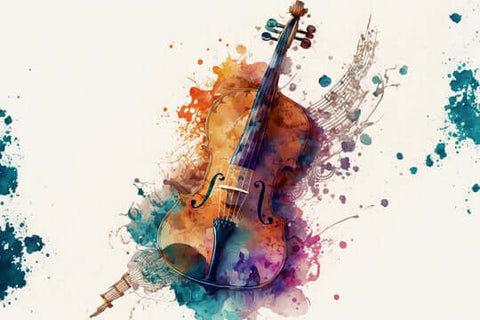
The violin family stands out as one of the most renowned groups within stringed instruments due to their elegant sound and remarkable versatility. This family encompasses instruments such as violins, violas, cellos, and double basses – each possessing unique characteristics and requiring bow play techniques.
The violin, known for its vibrant and soaring tones, is commonly linked to classical music but also finds its place in genres like folk and jazz. The viola, a slightly larger instrument than the violin, offers a deeper and mellower sound that adds warmth and richness to orchestral compositions. As for the cello, being much larger than both the viola and violin, it produces a resonant sound that can evoke both melancholy and power. Lastly, we have the double bass, which is the largest member of the violin family. It provides a solid foundation and delivers deep bass notes to an ensemble.
The Parts of Violin:
Here are some famous violin players
1. Niccolò Paganini (1782–1840).

Niccolò Paganini was an Italian violinist, violist, guitarist, and composer. He is widely considered as one of the best violinists of all time, known for his exceptional skill and emotional playing.
Paganini's compositions, such as the 24 Caprices for Solo Violin, are still significant works in the violin repertoire. His virtuoso performances and intriguing attitude helped cement his legendary standing in classical music.
2. Jascha Heifetz (1901–1987)

Jascha Heifetz, a Russian-American violinist, was widely regarded as one of the finest violinists of the twentieth century. Heifetz, known for his flawless technique and pure tone, began his professional career at the age of seven and swiftly ascended to international prominence.
His vast recordings and concerts established a new standard for violin playing, inspiring subsequent generations of violinists.
3. Itzhak Perlman (born 1945)

Itzhak Perlman is an Israeli-American violinist, conductor, and music educator. Born in Tel Aviv, he overcame polio as a child and went on to become one of the most famous violinists of his day.
Perlman is recognized for his warm tone and exceptional technique. He has performed with the world's top orchestras and received countless accolades, including multiple Grammy and Emmy Awards.
4. Hilary Hahn (born 1979).

Hilary Hahn is an American violinist known for her incisive interpretations, technical skill, and innovative programming. She made her big orchestral debut at the age of 12 and has since become one of the most prominent violinists of her generation.
Hahn is noted for her diverse repertoire, which includes both classical masterpieces and modern music, and she has received numerous Grammy Awards for her recordings.
5. Anne-Sophie Mutter (born 1963)

Anne-Sophie Mutter is a German violinist renowned for her technical accuracy, interpretive depth, and diverse repertory. Her international debut was at the age of 13 under Herbert von Karajan's leadership.
Mutter has subsequently had a notable career, performing with big orchestras and working with renowned composers. She is also committed to music education and philanthropy, having established the Anne-Sophie Mutter Foundation to help young artists.
6. Sarah Chang (born 1980).

Sarah Chang is an American violinist of Korean heritage who has been regarded as a prodigy from a young age. She made her debut with the New York Philharmonic when she was eight years old and has gone on to have a successful career.
Chang is renowned for her forceful performances and diverse repertoire, which ranges from classical to modern works. She has garnered various prizes and recognition for her contributions to music.
7. Joshua Bell (born 1967).

Joshua Bell is an American violinist and conductor known for his talent, passion, and charisma. He started playing the violin at the age of four and made his professional debut with the Philadelphia Orchestra when he was fourteen.
Bell's career has included concerts with major orchestras throughout the world, several recordings, and collaborations with a diverse range of musicians. He plays the Gibson Stradivarius, a 1713 violin created by Antonio Stradivari.
2. The Guitar: The Versatile Instrument

Moving on to another beloved stringed instrument widely used in popular music-The guitar. Its versatility shines through its six strings that can be played using either a pick or our fingers. The guitar finds its place in various genres, including rock, pop, jazz, and even classical music. When it comes to acoustic guitars, their hollow bodies amplify the sounds of their strings, whereas electric guitars rely on pickups and amplifiers for sound production.
The Parts of Guitar
Here are some famous Guitar players
1. Jimi Hendrix (1942–1970)

Jimi Hendrix, an American rock guitarist, singer, and composer, is largely recognized as one of the finest electric guitarists in music history. Hendrix, renowned for his inventive guitar playing skills and dramatic performances, transformed the sound of rock music.
Hits like "Purple Haze," "Hey Joe," and his performance of "The Star-Spangled Banner" at Woodstock are still famous. His use of distortion and feedback created new techniques to play the electric guitar.
2. Eric Clapton (born 1945).

Eric Clapton is a British rock and blues guitarist, singer, and composer. Clapton, also known as "Slowhand," is the only person to have been inducted into the Rock and Roll Hall of Fame three times: once as a solo artist and again as a member of the Yardbirds and Cream.
Clapton is known for his smooth, melodic playing and emotional depth, including classics like as "Layla," "Tears in Heaven," and "Wonderful Tonight." He is well-known for his effect on modern rock and blues music.
3. Jimmy Page (born 1944)

4. B.B. King (1925–2015).

B.B. King (born Riley B. King) was an American blues singer, electric guitarist, songwriter, and record producer. He was known as the "King of the Blues" because of his expressive, soulful playing style and distinctive vibrato.
King's hit songs include "The Thrill Is Gone," "Every Day I Have the Blues," and "Lucille." His career lasted six decades, and he impacted numerous guitarists with his emotional depth and technical ability.
5. Carlos Santana (born 1947).

Carlos Santana is a Mexican-American guitarist best known for his work with the band Santana, which pioneered the synthesis of rock and Latin American music. His unusual, melodic guitar approach, as well as his ability to merge numerous musical genres, have established him as a unique character in the music industry.
Santana's hit songs include "Black Magic Woman," "Oye Como Va," and "Smooth." He has received numerous Grammy Awards and is widely recognized for his contributions to world music.


6. Eddie Van Halen (1955–2020).

Eddie Van Halen, a Dutch-American musician, songwriter, and producer, was best known as the lead guitarist for the rock band Van Halen. Van Halen, known for his virtuoso guitar playing and inventive methods such as tapping, transformed the sound of rock guitar.
Some of his best-known works include "Eruption," "Jump," and "Panama." His technical prowess and influential approach have made a lasting impression on rock music.
7. André Segovia (1893–1987)

Andrés Segovia was a Spanish classical guitarist who is often regarded as the father of contemporary classical guitar. Segovia's contributions to music include transcriptions of classical compositions for guitar and his role in popularizing the guitar as a concert instrument.
He helped legitimate the classical guitar in the eyes of the music industry and performed all his life, creating a lasting legacy through his recordings and seminars.
8. Django Reinhardt (1910–1953)

Django Reinhardt was a Belgian-born Romani-French jazz guitarist and composer. Reinhardt, a pioneering virtuoso, is considered as one of history's best guitarists, despite losing two fingers on his left hand in a fire.
He created a distinct style of playing known as "gypsy jazz," and his tunes "Minor Swing," "Nuages," and "Django" are jazz standards. His creative approach and lasting impact continue to inspire guitarists.
3. The Harp: a Melodious Instrument
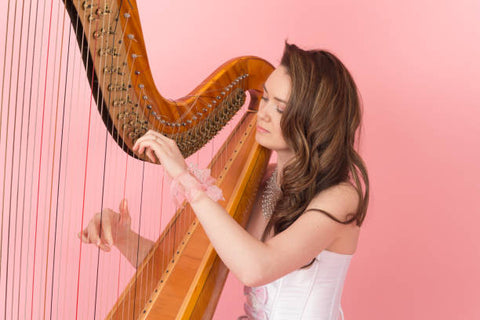
Now, let's explore another captivating stringed instrument - the harp. Often associated with heavenly melodies played by angels themselves due to its grand size and elegant design. Its enchanting sound brings about a soothing and ethereal experience.
The harp produces music by plucking its strings using either the fingers or a special pick called a plectrum. Harps come in different sizes, ranging from small lap harps to large concert pedal harps. Due to its unique construction and delicate sound, the harp is widely recognized as an important instrument in classical, folk, and even contemporary music.
The Parts of Harp
Here are some famous Harp players
1. Carlos Salzedo (1885–1961).

Carlos Salzedo, a French-American harpist, composer, and conductor, is widely regarded as one of the most influential harpists of the twentieth century. Salzedo was born in France and emigrated to the United States in 1909. He made substantial advances to harp technique and education.
He established the harp department at the Curtis Institute of Music and was well-known for his unique harp compositions and arrangements. Many of his students have gone on to become well-known harpists.
2. Nicanor Zabaleta (1907–1993)

Nicanor Zabaleta was a Spanish harpist who helped popularize the harp as a solo instrument during the twentieth century. Zabaleta started his studies in Spain and pursued them in France and the United States.
His lengthy performing career extended five decades, during which he launched numerous new compositions for the harp and recorded widely. Zabaleta's artistic and technical abilities elevated the harp to new heights of fame and respect.
3. Marcel Grandjany (1891–1975)

Marcel Grandjany was a well-known French-American harpist, composer, and teacher who made significant contributions to harp education and performance. Grandjany attended the Paris Conservatory and established a great career as a soloist and orchestral harpist.
He relocated to the United States, where he taught at the Juilliard School and Manhattan School of Music. His compositions and transcriptions for the harp are extensively performed, and his teaching methods have impacted generations of harpists.
4. Alice Giles (born 1961)

Alice Giles is an Australian harpist known for her dexterity and variety. She has appeared as a soloist with renowned orchestras all around the world and has a varied repertoire that includes classical, contemporary, and Australian compositions.
Giles is also an active teacher, having taught at institutions such as the Sydney Conservatorium of Music. Her contributions to the harp include several recordings and the development of new compositions for the instrument.
5. Yolanda Kondonassis (born 1963)

Yolanda Kondonassis is an American harpist known for her energetic performances and rich discography. She has performed as a soloist with renowned orchestras and recorded a number of critically acclaimed albums.
Kondonassis is also an active educator, teaching at the Cleveland Institute of Music and Oberlin Conservatory. She is well-known for her attempts to broaden the harp repertoire and her dedication to modern music.
6. Harpo Marx (1888–1964)

Harpo Marx (born Adolph Marx) was an American comedian, actor, and singer, best known as one of the Marx Brothers. Harpo was mostly known for his humorous appearances in cinema and on stage, but he was also a talented harpist.
He taught himself how to play the instrument and frequently used it in his shows, bringing the harp to the notice of a large audience. His distinct style and hilarious persona make him one among the most well-known harpists in popular culture.
7. Catrin Finch (born 1980)

Catrin Finch is a Welsh harpist known for her technical mastery and captivating performances. She was the Prince of Wales' Official Harpist and has performed with the world's best orchestras.
Finch's repertoire includes classical, contemporary, and traditional music, and she has participated in numerous cross-genre collaborations. Her recordings have gained critical acclaim, and she is known for her efforts to introduce the harp to new audiences.
8. Xavier de Maistre (born 1973)

Xavier de Maistre is a French harpist known for his remarkable technique and passionate style. He has performed as a soloist with major orchestras and has a large record. De Maistre began his career as the Vienna Philharmonic's main harpist before pursuing a solo career.
He is also an enthusiast for increasing the harp repertoire, having debuted numerous new compositions. His contributions to the harp include both performance and education, which have inspired many new harpists.
4. The Mandolin: A Hidden Jewel
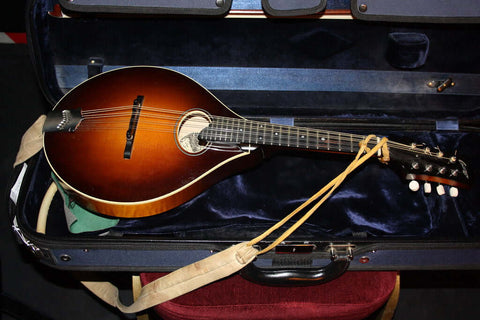
The mandolin, though not as well known, is an intriguing small stringed instrument that emits a bright and distinctive sound. It evolved from the lute family and gained popularity during the Renaissance in Italy. With four pairs of steel strings that can be plucked or strummed, the mandolin's sound can vary from intimate and delicate to bold and vibrant. It finds extensive use in various music genres like bluegrass, folk, and classical music.
The Parts of Mandolin
Here are some famous Mandolin players
1. Bill Monroe (1911–1996).

Bill Monroe, an American mandolinist, singer, and songwriter, is generally referred to as the "Father of Bluegrass." He established the bluegrass genre, called after his band, the Blue Grass Boys. Monroe's quick, sophisticated mandolin playing and high-pitched singing established the standard for bluegrass music.
His most famous tunes are "Blue Moon of Kentucky," "Uncle Pen," and "Kentucky Waltz." Monroe's influence continues to inspire bluegrass musicians throughout the world.
2. Chris Thile (born 1981).

Chris Thile is an American mandolinist, singer, and songwriter best known for his work with the progressive acoustic trio Nickel Creek and the band Punch Brothers. Thile is renowned for his virtuoso technique, inventive compositions, and genre-spanning collaborations.
He has won several Grammy Awards and was designated a MacArthur Fellow in 2012. Thile's solo work and collaborations with musicians from many genres have broadened the scope of mandolin music.
3. David Grisman (born 1945)

David Grisman, an American mandolinist and composer, is noted for his eclectic style that combines bluegrass, jazz, folk, and world music. He created the phrase "Dawg music" to characterize his distinct sound.
Grisman has worked with many performers, including Jerry Garcia of the Grateful Dead, and is a prominent figure in the acoustic music movement. His records and performances have influenced numerous mandolin players and musicians.


4. Sam Bush (born 1952).

Sam Bush is an American mandolinist and multi-instrumentalist best recognized for his pioneering work in newgrass, a progressive type of bluegrass music. Bush co-founded the prominent band New Grass Revival and has collaborated with a number of other notable performers.
His aggressive playing and unique approach have earned him the nickname "The King of Telluride" as a result of his repeated performances at the Telluride Bluegrass Festival. Bush remains a key presence in contemporary bluegrass and acoustic music.
5. Carlo Aonzo (born 1967).

Carlo Aonzo is a well-known Italian mandolinist who performs both classical and contemporary pieces. He has won various international competitions and performed with the world's most prominent orchestras.
Aonzo is also a committed teacher who gives seminars and workshops all over the world. He is well-known for his attempts to revitalize and promote the classical mandolin repertoire, and he has produced several critically acclaimed albums.
6. Mike Marshall (born 1957).

Mike Marshall is an American mandolinist and multi-instrumentalist who excels at bluegrass, classical, jazz, and Brazilian choro. He has collaborated with David Grisman, Béla Fleck, and other well-known musicians.
Marshall is also an accomplished recording artist and educator, having co-founded the Mandolin Symposium and ArtistWorks, an online school. His unique playing and instruction have had a huge impact on the mandolin community.
7. Jacob Reuven (born 1976)

Jacob Reuven is an Israeli mandolinist renowned for his dexterity and varied repertoire, which spans classical, folk, and modern music. He has performed with the world's best orchestras and groups and is a founding member of the quartet 3.
Reuven is also a passionate teacher, preparing the next generation of mandolinists. His contributions to the mandolin include numerous albums and collaborations with well-known composers and performers.


8. Jethro Burns (1920–1989)

Jethro Burns, born Kenneth Charles Burns, was an American mandolinist and comedian best known for his role as one half of the musical comedy team Homer and Jethro. Burns was also a well-known jazz mandolinist who played in a sophisticated, swing-inspired style.
He impacted many mandolinists with his creative approach to jazz and rigorous teaching schedule. Burns' legacy includes multiple recordings, educational publications, and a lasting influence on the mandolin community.
5. The Banjo: Adding a Unique Flair

With its unmistakable twangy sound, the banjo brings a distinctive touch to the world of stringed instruments. Originating from Africa and introduced to the United States by enslaved Africans, it typically features four or five strings that are played through picking or strumming techniques. The banjo holds a prominent place in traditional American music genres such as bluegrass, country, and folk.
Guitars and Banjos are so old but still beautiful. Sometimes you can't even imagine which one sounds better. After all, there are many types of guitar and banjo, and not even their categories are the same. But keeping the main idea, you may want to find out what is the main difference between a guitar and a banjo
The Parts of Banjo
Here are some famous Banjo players
1. Earl Scruggs (1924–2012).

Earl Scruggs was an American banjo player and musician who popularized the three-finger picking approach, also known as the "Scruggs style," which has become a distinguishing aspect of bluegrass music.
He rose to prominence as a member of Bill Monroe's Blue Grass Boys before forming his own band, Flatt and Scruggs. His creative playing on classics such as "Foggy Mountain Breakdown" and "The Ballad of Jed Clampett" made an enduring impression on banjo and bluegrass music.
2. Béla Fleck (born 1958).

Béla Fleck is an American banjo musician recognized for his varied and genre-defying style. He has experimented with bluegrass, jazz, classical, and world music, stretching the limits of what the banjo can do.
Fleck is best known as the leader of the band Béla Fleck and the Flecktones, which combines numerous musical influences. He has received numerous Grammy Awards in various genres, cementing his position as one of the most inventive banjo players.
3. Ralph Stanley (1927–2016).

Ralph Stanley was an American bluegrass banjoist, singer, and songwriter. As a member of the Stanley Brothers and later as a solo artist, Stanley contributed significantly to the development of bluegrass and old-time music.
His unusual clawhammer banjo approach and high-lonesome singing voice defined his sound. Stanley's talents to the genre earned him various honors, including a Grammy Award for his role in the film "O Brother, Where Art Thou?"
4. Tony Trischka (born 1949)

Tony Trischka, an American banjo musician and teacher, is noted for his creative approach to the instrument. He played a vital role in the development of newgrass and current banjo music.
Trischka has made a number of influential CDs and published several banjo tuition manuals. His creative techniques and contributions to banjo teaching have influenced many aspiring banjoists.


5. Alison Brown (born 1962)

Alison Brown is an American banjo player, guitarist, and composer who combines bluegrass, jazz, and folk music. Brown, a former member of Alison Krauss & Union Station, has enjoyed a successful solo career and co-founded Compass Records.
Her CDs, including "Fair Weather" and "Stolen Moments," highlight her virtuosity musicianship and inventive compositions. Brown's banjo talents, as well as her job as a record label executive, have elevated her to the ranks of contemporary acoustic music's leading figures.
6. Noam Pikelny (born 1981)

Noam Pikelny is an American banjo player best known for his collaborations with the Punch Brothers and as a solo performer. Pikelny has received recognition for his technical abilities and unique approach to the banjo. He has won numerous prizes, including the Steve Martin Prize for Excellence in Banjo and Bluegrass.
Pikelny's contributions to the progressive bluegrass scene, as well as his collaborations with other notable artists, have reinforced his reputation as a premier modern banjoist.
7. Pete Seeger (1919–2014).

Pete Seeger was an American folk musician, singer, and social activist best recognized for his banjo playing and contributions to the American folk music revival. Seeger's unusual playing technique and use of the banjo to advocate social change helped him become an iconic figure.
Songs like "If I Had a Hammer," "Turn! Turn! Turn!," and "Where Have All the Flowers Gone?" are still classics. Seeger's influence extends beyond music to his activism for social rights, environmental issues, and peace.
8. Abigail Washburn (born 1977).

Abigail Washburn is an American banjo player, singer, and composer whose music combines American folk, bluegrass, and Chinese influences. Washburn is fluent in Mandarin and has performed widely in China, collaborating with Chinese musicians.
She is a member of the band Uncle Earl and has produced several solo recordings. Washburn's unusual cultural blend and distinct banjo style have earned her critical recognition and a diverse audience.
6. The Sitar: Embarking on a Melodic Journey

Venturing away from Western musical instruments, the sitar guides us on a captivating voyage to India. This plucked string instrument boasts a long neck, a resonating gourd and movable frets. Its enchanting sound encapsulates the intricate and culturally rich traditions of Indian classical music. Playing the sitar involves skillfully plucking its strings and utilizing techniques such as bending and sliding to craft emotive melodies.
The Parts of Sitar
Here are some famous Sitar players
1. Ravi Shankar (1920–2012)

Ravi Shankar, an Indian sitar musician and composer, is widely recognized as one of the best sitar players of the twentieth century. He was instrumental in popularizing Indian classical music in the West, partnering with Western performers including George Harrison of The Beatles.
Shankar's emotive performance and profound musicality made him a global champion for Indian music. His significant pieces include "Sitar Concerto No. 1" and a variety of classical ragas.
2. Anoushka Shankar (born 1981).

Anoushka Shankar is a British-Indian sitar musician and composer who is Ravi Shankar's daughter. Her father trained her, and she has built out a thriving career for herself, merging traditional Indian music with current genres such as electronic, jazz, and world music.
Anoushka has received multiple Grammy Award nominations for her albums "Traveller," "Traces of You," and "Reflections." Her creative approach and collaborations with a variety of musicians have pushed the frontiers of sitar music.
3. Vilayat Khan (1928–2004)

Vilayat Khan was an Indian sitar player from the Imdadkhani gharana. Khan was a highly regarded sitarist of his time, known for his remarkable technical ability and emotive performance.
He created the "Gayaki Ang" (voiced style) of sitar playing, which emulates the nuances of the human voice. His recordings and performances of ragas like as Yaman, Darbari Kanada, and Bhairav are well-regarded in the classical music community.
4. Nikhil Banerjee (1931–1986)

Nikhil Banerjee was an Indian sitar performer known for his intimate knowledge of Indian classical music and his meditative, heartfelt performances. Banerjee, a pupil of Allauddin Khan, was known for his lyrical playing and sophisticated rhythmic patterns.
His performances of ragas including Malkauns, Bageshree, and Desh are regarded as classics. Despite his brief life, Banerjee left a lasting legacy through his recordings and influence on subsequent musicians.
5. Shahid Parvez (born 1955)

Shahid Parvez is an Indian sitar virtuoso of the Etawah gharana. Parvez, known for his excellent technique and improvisational skills, has performed all over the world. He is renowned for his ability to smoothly integrate "Gayaki Ang" (singing style) with "Tantrakari Ang" (instrumental style).
Parvez's contributions to the sitar include countless recordings as well as attempts to train and guide emerging performers, ensuring that the classical legacy lives on.
6. Buddhadev Dasgupta (1933–2018)

Buddhadev Dasgupta was an Indian sitar and surbahar performer renowned for his sophisticated interpretations of Indian classical music. Dasgupta, a Radhika Mohan Maitra pupil, was well-known for his strict commitment to raga performance as well as his mastery on the sitar and surbahar.
His renditions of ragas such as Shree, Darbari Kanada, and Marwa were widely lauded. Dasgupta also made significant contributions to musicology through his papers and talks.
7. Imrat Khan (1935–2018)

Imrat Khan, an Indian sitar and surbahar player from the Imdadkhani gharana, was well-known for his abilities on both instruments. Imrat, Vilayat Khan's brother, was well-known for his profound, meditative renditions of ragas and mastery of the surbahar's complex skills.
He performed all over the world and taught a large number of students, thereby spreading awareness and appreciation for Indian classical music. His contributions include some highly regarded recordings and performances.
8. Manilal Nag (born 1939)

Manilal Nag is a Bishnupur gharana-trained Indian sitar player recognized for his traditional approach and in-depth mastery of the ragas. Nag's playing is distinguished by its purity and devotion to classical ideals, with a focus on the emotional and spiritual qualities of the music.
He has played extensively in India and internationally, and his recordings are valued for their genuineness and creative purity. Nag's commitment to the classical form has elevated him to prominence in Indian music.
7. The Lute: Exuding Renaissance Elegance
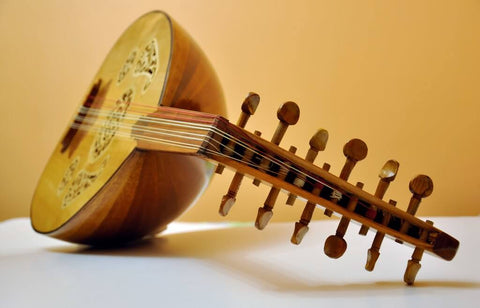
Lastly, let's explore the lute—an instrument that experienced soaring popularity during the remarkable Renaissance era. With its pear-shaped body, fretted neck, and multiple strings plucked by nimble fingers, it emits a sonorous tone that emanates warmth and intimacy.
Esteemed for both solo performances and accompaniment, the lute's historical significance and distinctive sound continues to inspire musicians and composers alike.
The Parts of Lute
Here are some famous Lute players
1. John Dowland (1563–1626).

John Dowland was an English Renaissance composer, lutenist, and singer. He is most renowned for his melancholy songs and instrumental music, which have remained popular ever since their creation.
Dowland's masterpieces, such "Flow My Tears" and "Lachrimae," demonstrate his mastery of the lute and capacity to express deep emotion via song. His legacy lives on, since he is regarded as one of the finest lute composers of all time.
2. Julian Bream (1933–2020).

Julian Bream was a British classical guitarist and lutenist known for his virtuoso technique and expressive style. Bream was instrumental in restoring interest in the lute and its repertoire during the twentieth century.
He gave numerous performances and recordings, introducing contemporary listeners to the music of Renaissance and Baroque composers. Bream's contributions to both guitar and lute music have made a lasting impression on the classical music world.
3. Paul O'Dette (born 1954)

Paul O'Dette is an American lutenist and conductor who is widely considered as one of the foremost figures in the field of early music. He has a large repertoire, including renowned recordings of works by John Dowland, Francesco da Milano, and other Renaissance and Baroque composers.
O'Dette is also a passionate educator, having taught at several institutions, including the Eastman School of Music. His painstaking research and historically informed performances have brought him international acclaim.
4. Nigel North (born 1954)

Nigel North is a British lutenist who specializes in Renaissance and Baroque music. He has performed and recorded numerous works by John Dowland, J.S. Bach, and Silvius Leopold Weiss.
North nuanced interpretations and technical prowess have established him as a key player in the early music scene. He is also a successful instructor, having worked at various notable universities, including Indiana University.
5. Hopkinson Smith (born 1946)

Hopkinson Smith is an American lutenist known for his renditions of Renaissance and Baroque music. He studied with Emilio Pujol and Eugen Müller-Dombois and has had a successful career as a soloist and recording artist.
Smith's recordings of works by Francesco da Milano, Sylvius Leopold Weiss, and J.S. Bach are widely praised. His passion to the lute and its repertoire has greatly aided the instrument's modern resurgence.
6. Jakob Lindberg (born 1952).

Jakob Lindberg is a Swedish lutenist recognized for his diverse repertoire and historical performing style. He has recorded extensively, ranging from the Renaissance to the Baroque periods.
Lindberg is also a lute professor at London's Royal College of Music, where he has had a significant impact on his students. His recordings of works by John Dowland, Francesco da Milano, and other composers have received high praise for their authenticity and musicality.
7. Rolf Lislevand (born 1961)

Rolf Lislevand, a Norwegian lutenist and guitarist, is noted for his creative approach to early music. He combines historical performance traditions with current improvisation to create new interpretations of Renaissance and Baroque music.
Lislevand has made multiple recordings with works by Kapsberger, Piccinini, and other composers. His distinct approach and entertaining performances have won him a high profile in the early music field.
8. Elizabeth Kenny (born 1966).

Elizabeth Kenny is a British lutenist renowned for her flexibility and significant work in early music. She has performed with renowned ensembles and orchestras, such as the Orchestra of the Age of Enlightenment and the Academy of Ancient Music.
Kenny's recordings span a wide variety of genres, from Renaissance lute tunes to Baroque solo compositions. She is also a respected educator, having taught at places including the Royal Academy of Music and the University of Oxford.
Conclusion
In conclusion, stringed instruments have played an indispensable role in shaping the world of music for countless centuries. From bows that bring forth melodic vibrations to strings that resonate harmoniously, each component of these instruments contributes significantly to their sonic magic.
From the masterful melodies produced by the violin family to the versatile guitar, the heavenly sounds of the harp and the distinctiveness of instruments like mandolin and banjo, along with the melodic journey of the sitar and the elegance exuded by the lute, stringed instruments have a timeless appeal that never fails to captivate audiences and ignite inspiration among musicians globally.
Author bio:

Dr. Robin Alexander
Dr. Robin Alexander, an MD Pathologist and passionate guitarist, combines his love for music and science. As a guitar enthusiast, he shares valuable insights and tips on guitar playing here at Guitarmetrics, helping musicians enhance their skills and enjoy their musical journey.


